
Screening plants provide dense foliage and structure to create privacy and block unsightly views, while climbing vines use vertical surfaces to grow and can add a natural, decorative cover without heavy maintenance. Explore the rest of the article to discover which option suits your garden's aesthetic and practical needs best.
Table of Comparison
| Feature | Screening Plants | Climbing Vines |
|---|---|---|
| Growth Habit | Self-supporting shrubs or trees | Require support structures to climb |
| Space Requirement | Needs wider ground space | Minimal ground space, climbs vertically |
| Installation | Plant directly in soil | Needs trellis, fence, or wall for support |
| Maintenance | Pruning and shaping needed | Regular training and trimming required |
| Privacy Effectiveness | Dense foliage provides good privacy | Dense coverage depends on support and plant vigor |
| Growth Rate | Varies by species, moderate to slow | Generally fast-growing |
| Examples | Privet (Ligustrum), Arborvitae (Thuja) | English Ivy (Hedera helix), Clematis |
| Uses | Privacy screens, windbreaks, visual barriers | Wall coverage, curtain effects, erosion control |
Introduction to Screening Plants and Climbing Vines
Screening plants such as arborvitae, boxwood, and laurel create dense, structured barriers ideal for privacy and wind protection. Climbing vines like clematis, wisteria, and ivy offer vertical coverage by growing along trellises, fences, or walls, adding aesthetic appeal and enhancing green space in compact areas. Both options vary in maintenance needs and growth rates, making them versatile choices for garden design and outdoor screening solutions.
Key Differences Between Screening Plants and Climbing Vines
Screening plants are typically bushy, dense, and self-supporting, making them ideal for creating privacy barriers or windbreaks without additional structures. Climbing vines rely on external supports such as trellises, fences, or walls to grow vertically, offering versatile coverage and decorative appeal. Your choice depends on whether you prefer a standalone green screen or a dynamic, space-saving vertical garden.
Benefits of Using Screening Plants in Landscapes
Screening plants provide effective privacy, block unsightly views, and reduce noise pollution in landscapes, enhancing outdoor living spaces. They support local biodiversity by offering habitats and food sources for birds and pollinators, contributing to a healthier ecosystem. Maintenance is generally lower compared to climbing vines, as screening plants can be selected for their growth habits, disease resistance, and adaptability to specific soil and climate conditions.
Advantages of Climbing Vines for Privacy and Aesthetics
Climbing vines provide a natural and dense privacy screen that grows vertically on fences, walls, or trellises, effectively blocking views while enhancing outdoor aesthetics. Their rapid growth and adaptability to various climates make them a cost-efficient and low-maintenance option compared to traditional screening plants. Beyond privacy, flowering vines like jasmine or clematis add vibrant colors and pleasant fragrances, creating an appealing and inviting outdoor space.
Top Screening Plant Varieties for Residential Gardens
Top screening plant varieties for residential gardens include fast-growing evergreens like Leyland Cypress, which provide dense, year-round privacy. Climbing vines such as English Ivy and Star Jasmine are excellent for vertical coverage on fences or trellises, offering both aesthetic appeal and space-saving benefits. For a combination of speed and visual interest, varieties like Bamboo and Clematis deliver effective screening with vibrant foliage and flowers.
Popular Climbing Vines for Vertical Green Coverage
Popular climbing vines like English ivy, clematis, and jasmine offer excellent vertical green coverage by attaching to walls and trellises, providing lush privacy and aesthetic appeal. These vines grow rapidly, cover large areas, and require less space compared to traditional screening plants, making them ideal for narrow gardens or urban settings. You can choose specific varieties based on flower color, fragrance, and growth habits to complement your outdoor design.
Choosing the Right Option: Factors to Consider
Selecting between screening plants and climbing vines depends on factors like space availability, growth speed, and maintenance needs. Screening plants typically offer denser coverage and may require more ground space, while climbing vines excel in vertical growth and can quickly cover walls or trellises. Assess your garden's layout and desired privacy level to determine which option best suits your landscaping goals.
Maintenance Requirements for Screening Plants vs Climbing Vines
Screening plants typically require regular pruning and occasional feeding to maintain their shape and density, while climbing vines need consistent training and support adjustments to prevent overgrowth and damage to structures. Your choice depends on your willingness to perform routine maintenance; screening plants provide a more controlled growth pattern, whereas climbing vines demand more frequent attention to keep them in check. Selecting the right option ensures manageable upkeep and a healthy, attractive green barrier.
Design Ideas: Combining Screening Plants and Climbing Vines
Combining screening plants and climbing vines enhances garden privacy with layered textures and vibrant colors. You can use tall screening shrubs as a solid backdrop while vines climb trellises or arbors to add vertical interest and seasonal blooms. This design approach maximizes space and creates a dynamic, visually appealing landscape that evolves throughout the year.
Conclusion: Enhancing Privacy and Beauty in Outdoor Spaces
Screening plants create dense, structured barriers that effectively enhance privacy while adding lush greenery to your outdoor space. Climbing vines offer versatile vertical coverage, softening fences and walls with vibrant foliage and flowers that boost aesthetic appeal. Choosing the right combination of screening plants and climbing vines maximizes both privacy and natural beauty, transforming your garden into a serene retreat.
 homyna.com
homyna.com